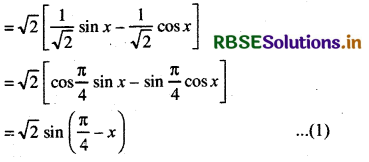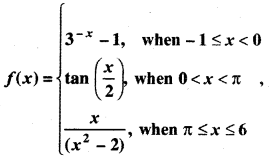RBSE Class 11 Maths Important Questions Chapter 2 Relations and Functions
Rajasthan Board RBSE Class 11 Maths Important Questions Chapter 2 Relations and Functions Important Questions and Answers.
Rajasthan Board RBSE Solutions for Class 11 Maths in Hindi Medium & English Medium are part of RBSE Solutions for Class 11. Students can also read RBSE Class 11 Maths Important Questions for exam preparation. Students can also go through RBSE Class 11 Maths Notes to understand and remember the concepts easily.
RBSE Class 11 Maths Chapter 2 Important Questions Relations and Functions
Question 1.
If f: R → R, f(x) = x2, then find :
(i) Range of f,
(ii) {x |f(x) = 4},
(iii) {y |f(y) = -1}
Answer:
(i) Given, f: R → R
and f(x) = x2
then if x < 0 ⇒ x2 > 0
x = 0 ⇒ x2 = 0
x > 0 ⇒ x2 > 0
So, f(x) = x2 > 0 ∀ x ∈ R
Hence, range of R = R+ ∪ {0} or {x ∈ R|0 ≤ x < ∞}

(ii) f(x) = 4
⇒ x2 = 4 ⇒ x = ± 2
Hence, {x : y (x) = 4} = {-2, 2}.
(iii) f(y) = - 1
⇒ y2 = - 1 ⇒ y = ± y√-1 ∉ R
⇒ {y:f(y) = - 1} = Φ null set.
Question 2.
Let A = {-2, -1, 0, 1, 2} and function f is defined in A to R by f(x) = x2 + 1. Find the range of f
Answer:
Given, A = {- 2, - 1, 0, 1, 2}
and R = set of real numbers
Given : f(x) = x2 + 1
then f(- 2) = (- 2)2 + 1 = 5
f(- 1) = (- 1)2 + 1 = 2
f(0) = (0)2 + 1 = 1
f(1) = (1)2 + 1 = 2
f(2) = (2)2 + 1 = 5
Hence, range of f = {1, 2, 5}.
Question 3.
Find domain and Range of function f which is defined by.
f(x) = \(\frac{1}{2-\cos 3 x}\)
Answer:
Given, function f(x) = \(\frac{1}{2-\cos 3 x}\)
We know that for real x, value of cos 3x lies between -1 and 1.
∴ - 1 ≤ cos 3x ≤ 1, “x ∈ R
According to definition of function
2 - cos 3x ≠ 0, “x ∈ R
∴ Function is defined for ∀ x ∈ R
∴ Domain of f = R
Again, maximum value of cos 3x is
∴ f(x) maximum value of f(x) is = 1
and minimum value of cos3x is - 1
∴ Minimum value of f(x) = \(\frac{1}{2-(-1)}\) = \(\frac{1}{3}\)
Thus, Range of f = [\(\frac{1}{3},\) 1]

Question 4.
If f: R → R is defined such that f(x) = x2 + 3, then find f-1(28) and f-1(- 5).
Answer:
Given, f(x) = x2 + 3 then f-1 (28)
⇒ x2 + 3 = 28
⇒ x2 = 28 - 3 = 25
⇒ x = ±5
∴ f-1(28) = {-5, 5)
Again f-1(-5) → x2 + 3 = - 5
⇒ x2 = - 8
⇒ x = ±√-8 ∉ R
∴ f-1 (- 5) = Φ
Question 5.
Find domain and Range of following defined functions:
(i) f(x) = sin x - cos x
(ii) f(x) = |sin x|
Answer:
(i) Given, f(x) = sin x - cos x.

∀ x ∈ R, f(x) = √2 sin (\(\frac{\pi}{4}\) - x) is real
∴ Domain of f = R (Set of real numbers)
Again Range of sin (\(\frac{\pi}{4}\) - x) is [-1, 1]
∴ Range of f = [-√2, √2]
(ii) According to question, f(x) = |sin x|
∀ x ∈ R, value of f(x) will be real since |sin x| is real.
∴ Domain of f = R [since domain of sin x is R
∴ Domain of |sin x| will be R
We know that
⇒ 0 ≤ |sin x| ≤ 1
f(x) = Range of |sin x| = [0, 1]
[Since if sin x = - 1 then |sin x| = |- 1|= 1
and if sin x = 1 then |sin x| = |1| = 1
Question 6.
If f: R → R is defined such that f(x) = 3x, then find (i) Range of f (ii) {x: f(x) = 1}, (iii) Is f(x + y) = f(x). f(y) true.
Answer:
(i) Since value of f(x) = 3x is positive for all x ∈ R and for all x > 0 log3 x ∈ R exist such that
f(log3 x) = 3log 3x = x [∵ a loga x = x]
∴ Range of f is set of all positive real numbers
(ii) f(x) = 1
⇒ 3x = 1
⇒ 3x = 30 ,
⇒ x = 0
∴ [x : f(x) = 1] = {0}
(iii) f(x + y) = 3x + y
= 3x . 3y = f(x) . f(y)
∴ f(x + y) = f(x).f(y) is true for all x, y ∈ R

Question 7.
(i) If f(x) = ax2 + bx + c, then find f(0), f(a), f(b)
(ii) If f(x) = x4 - \(\frac{1}{x^4}\), then prove that f(x) = - f\(\left(\frac{1}{x}\right)\)
(iii) If y = f(x) = \(\frac{x+2}{x-1}\), then prove that x = f(y)
Answer:
(i) We have, f(x) = ax2 + bx + c then f(0) = a.0 + b.0 + c = c
f(a) = a.a2 + b.a + c
= a3 + ab + c
then f(b) = a.b2 + b.b + c
= ab2 + b2 + c
(ii) f(x) = x4 - \(\frac{1}{x^4}\), then

(iii) y = f(x) = \(\frac{x+2}{x-1}\)
∴ y = \(\frac{x+2}{x-1}\)
⇒ (x - 1)y = x + 2
⇒ xy - y = x + 2
⇒ xy - x = y + 2
⇒ x(y - 1) = y + 2
⇒ x = \(\frac{y+2}{y-1}\) = f(y) [∴ f(x) = \(\frac{x+2}{x-1}\)]

Question 8.
If

then find:
(i) f(- 1)
Answer:
f(- 1) = 3-(-1) - 1
= 31 - 1 = 3 - 1 = 2
∴ f(- 1) = 2
(ii) f(π/6)
Answer:
f(π/6) = tan \(\left(\frac{\pi / 6}{2}\right)\) = tan \(\left(\frac{\pi}{12}\right)\) [∵ 0 < π / 6/ π]
= tan 15° = 2 - √3
(iii) f(2π/3)
Answer:
f\(\left(\frac{2 \pi}{3}\right)\) = tan \(\left(\frac{2 \pi}{3 \times 2}\right)\) = tan \(\frac{\pi}{3}\) [∵ 0 < 2π/3 < π]
= √3
(iv) f(4)
Answer:
f(4) = \(\frac{4}{4^2-2}=\frac{4}{16-2}=\frac{4}{14}=\frac{2}{7}\) = [∵ 0 < (4) < 6]
[∵ x lies in = 4, [π , 6]
(v) f(6)
Answer:
f(6) = \(\frac{6}{6^2-2}=\frac{6}{36-2}=\frac{6}{34}=\frac{3}{17}\) .
[∵ x lies in = 6, [π , 6]
Multiple Choice Questions
Question 1.
In the following which are functions from A to B, where A = {a, b, c} and B = {b, c, d}
(a) {(a, b)(a, d)(b, d),(c, c)}
(b) {(a,c),(b,d)}
(c) ((a, c), (b. b), (c, d)}
(d) {(a, b), (b, c), (c, b), (c, d)}.
Answer:
(c) ((a, c), (b. b), (c, d)}

Question 2.
If f:R → R is defined such that f(x) = x2 then f-1 (25) equals:
(a) 5
(b) - 5
(c) [- 5, 5]
(d) none of these
Answer:
(c) [- 5, 5]
Question 3.
If f = {(1, 2) (2, 3), (3, 4)}, then its inverse is :
(a) {(1,2), (3, 2), (4,3)}
(b) {(2,1) (3, 2), (4,3)}
(c) {(2,1), (3,2), (3,4)}
(d)None of the above
Answer:
(b) {(2,1) (3, 2), (4,3)}
Question 4.
If f:R → R is defined such that f(x) = x2 then f-1 (1, -5) equals to :
(a) 5
(b) {1,5 }
(c) Φ
(d) None of these
Answer:
(c) Φ
Question 5.
If f: R → R and g : R → R are defined such that f(x) = sin x and g(x) = x2, then (gof)(x) equals to:
(a) sin x2
(b) (sin x)2
(c) x2
(d) None of the above
Answer:
(b) (sin x)2
Question 6.
If f: R → R and g : R → R is defined such that f(x) = 2x, g(x) = x2 + 2, then (fog) (2) equals to:
(a) 12
(b) 11
(c) 24
(d) None of these
Answer:
(a) 12
Question 7.
If f(x) = \(\frac{2 x+3}{x-2}\); x ∈ R then \(\frac{f(10)}{f(1 / 2)}\) equals to :
(a) - \(\frac{69}{64}\)
(b) \(\frac{64}{69}\)
(c) - \(\frac{64}{69}\)
(d) None of these
Answer:
(a) - \(\frac{69}{64}\)

Question 8.
Domain of function defined by f(x) = \(\sqrt{(x-1)(3-x)}\)
(a) [1, 3]
(b) [- 3, - 1]
(c) [-3, ∞]
(d) None of these
Answer:
(a) [1, 3]
Question 9.
Domain of function defined by
f(x) = \(\frac{1}{(2 x-3)(x+1)}\)
(a) R
(b) (0, ∞)
(c) R - {-1,3 / 2}
(d) None of these
Answer:
(c) R - {-1,3 / 2}
Question 10.
If f and g are real functions defined by f (x) = x2 + 7 and g(x) = 3x + 5, then value of f(3) + g(-5) equal to :
(a) 6
(b) 16
(c) 0
(d) - 10
Answer:
(a) 6
Question 11.
The range of the f(x) = \(\frac{|x|}{x}\) is equal to :
(a) {-1, 1}
(b) (- 1, 1)
(c) [-1, 1]
(d) {- 1, 0, 1}
Answer:
(a) {-1, 1}
Fill in the Blanks
Question 1.
If A and B are disjoint sets and n (4) = 2, n (B) = 3, then n(A × B) = .............................
Answer:
6
Question 2.
The domain of f(x) = √x + 7 = ................................
Answer:
[- 7, ∞]
Question 3.
If (4x + 3, y) = (3x + 5, - 2), then value of x is ..................................
Answer:
2

Question 4.
If R= {(2, 3) (\(\frac{1}{2}\), o) (2, 7) (- 4, 6)} then range of R is .............................
Answer:
{0, 3, 6, 7}
Question 5.
For any set A, A × Φ is .....................
Answer:
Φ
Question 6.
Let f(x) = x + 1, g(x) = x2 + x, then value of (f + g) (x) is .............................
Answer:
x2 + 2x + 1
Question 7.
The graph of an identify function always a ....................................
Answer:
straight line.
State True or False for the following statements:
Question 1.
If 4 = (1,2), then A × A × A = {(1, 1, 1) (2, 2, 2) (1, 2, 2) (2, 1, 1)}
Answer:
False
Question 2.
The order pair (5, 2) belong to the relation
R = {ix, y): y= - 5, x, y ∈ Z)
Answer:
False
Question 3.
The domain of f(x) = x2 + 2 always a real number.
Answer:
True
Question 4.
For any real function f(x) co-domain of f = Range of f always.
Answer:
False

Question 5.
The range of f(x) = 1 + cos x always a real number.
Answer:
False

- RBSE Solutions for Class 11 Maths Chapter 3 त्रिकोणमितीय फलन Ex 3.1
- RBSE Solutions for Class 11 Maths Chapter 2 संबंध एवं फलन विविध प्रश्नावली
- RBSE Solutions for Class 11 Maths Chapter 2 संबंध एवं फलन Ex 2.3
- RBSE Solutions for Class 11 Maths Chapter 2 संबंध एवं फलन Ex 2.2
- RBSE Solutions for Class 11 Maths Chapter 2 संबंध एवं फलन Ex 2.1
- RBSE Solutions for Class 11 Maths Chapter 1 समुच्चय विविध प्रश्नावली
- RBSE Solutions for Class 11 Maths Chapter 1 समुच्चय Ex 1.6
- RBSE Solutions for Class 11 Maths Chapter 1 समुच्चय Ex 1.5
- RBSE Solutions for Class 11 Maths Chapter 1 समुच्चय Ex 1.4
- RBSE Solutions for Class 11 Maths Chapter 1 समुच्चय Ex 1.3
- RBSE Solutions for Class 11 Maths Chapter 1 समुच्चय Ex 1.2